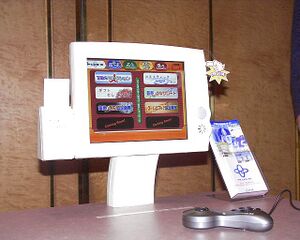Plus e
From Sega Retro

| |||||||||
| Plus e | |||||||||
|---|---|---|---|---|---|---|---|---|---|
| Manufacturer: JCM | |||||||||
|
The Plus e (プラスe), stylized as PLUS e, is a multimedia terminal manufactured by JCM, in collaboration with Hitachi Software Engineering, Tokyo Broadcasting System, BSI, Hitachi Keiyo Engineering, Hitachi Electronics Services, JSAT Corporation, and NTT Communications. It was announced on January 22, 2001, and trialed Skylark's Gusto Sekimae in Musashi, Tokyo, on the 25th, followed by 30 stores in March, and fully introduced into every interested companies' stores by July.[1]
These terminals were installed at various establishments in Japan, including family restaurants and izakaya pubs. The device is a touch screen terminal attached to a table, and allows people to play video games, read fortunes, and watch cartoons and music videos,[2] with some content being inexpensive and others being free.[1] It can be operated after inserting a contactless IC card that the user is given after being shown to their table.[1]
The system remained Japan-exclusive, despite plans to expand overseas by 2003.[1] Despite, JCM's annual sales growing to 9.242 billion yen after introducing Plus e, they burden of operating and maintaining the equipment left them with debts of approximately 25.311 billion. On August 5, 2004, the company filed for civil rehabilitation proceedings with the Tokyo District Court. The Plus e devices remained in all restaurants for over a year after, but were removed as of September 2005[2].
Many games and fortune telling software for Plus e were developed by Sega, namely its subsidiaries Hitmaker and Overworks (later Sega WOW).
Hardware
The terminal has a 12.1-inch TFT color LCD display (800 x 600 dots/260,000 colors) with an ultrasonic touch panel. The display measures 416.3 mm wide x 118.4 mm deep x 387.6 mm high, and weighs 6 kg. The main unit uses a Pentium III-700MHz CPU, has 128MB of memory (SDRAM), a 40GB HDD (Ultra ATA), a 100BASE-TX LAN interface, and two USB ports. It runs on the Windows 98 Second Edition OS.[3]
List of games
- Nakayoshi Sketch (2001)
- Hitofude Girl (2001)
- K Doro! (2001)
- Ryoko-sensei no Shinryoshitsu (2001)
- Uranai Obake Guide Spirit (2001)
- Sekai Isshuu Machigaisagashi (2001)
- Touch de Uno! 2: Kondo ha Futari de Touch Siyo! (2001)
- Hanabi-Fight (2001)
- Doraemon: Fushigina Jikuu Daibouken (2002)
- Funny Bowlers (2002)
- K Doro! Version 2 (2002)
- Ryoko-sensei no Shinryoshitsu Part 2 (2003)
External links
- Wikipedia.jp
- PLUS e (lost contents for Japanese multi-entertainment device; 2001-2005) by Lost Media Wiki
References
- ↑ 1.0 1.1 1.2 1.3 1.4 http://ascii.jp/elem/000/000/320/320099/ (Wayback Machine: 2015-07-05 05:14)
- ↑ 2.0 2.1 https://lostmediawiki.com/PLUS_e_(lost_contents_for_Japanese_multi-entertainment_device;_2001-2005) (Wayback Machine: 2024-05-28 00:27)
- ↑ https://dengekionline.com/data/news/2002/4/15/e38da4222941b7fa622cfd8c598f197a.html